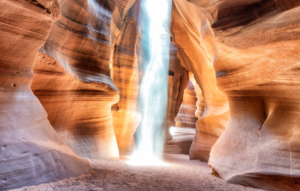Antelope Canyon, also known as “The place where water runs through rocks,” is a breathtaking natural wonder located in Arizona. This magnificent slot canyon has captivated visitors from around the world with its stunning beauty and unique geological formations.
In this blog post, we’ll delve into the captivating history of Antelope Canyon and uncover the secrets that lie within its majestic walls.
Formation and Geology
Antelope Canyon was formed over the course of hundreds of years through a combination of erosion and the powerful forces of nature. The erosion of Navajo Sandstone due to flash flooding and other sub-aerial processes played a significant role in shaping this remarkable canyon. Rainwater, particularly during the monsoon season, further sculpted and molded the canyon’s narrow passageways and smooth, flowing walls.
Navajo Beliefs and Legends
According to Navajo beliefs, the formation of Antelope Canyon is not solely attributed to natural erosion. Instead, it is believed that the Holy People, revered spiritual entities in Navajo culture, played a vital role in creating this extraordinary natural wonder. These legends highlight the deep connection between the Navajo people and the land they inhabit, where the spirit world intertwines with our own.
Discovery and Exploration
The exact story of the discovery of Antelope Canyon remains somewhat elusive. According to one Navajo tradition, a group of Navajo individuals initially refused to disclose the canyon’s location to outsiders. It wasn’t until the early 20th century that explorers began to venture into the canyon and document its awe-inspiring beauty.
Popularity and Tourism
Over the years, Antelope Canyon has become an iconic destination for photographers, nature enthusiasts, and travelers seeking a glimpse of its ethereal landscapes. The interplay of light and shadows within the narrow passageways creates a visual spectacle that has garnered international acclaim. Visitors are often left in awe as sunlight filters through the narrow openings, illuminating the captivating shapes and colors of the sandstone walls.
Preservation Efforts and Cultural Significance
Antelope Canyon holds immense cultural significance for the Navajo people, who have protected and preserved this sacred site for generations. It is essential to respect the Navajo Nation’s rules and regulations when visiting the canyon and to follow the guidance of local guides who share their knowledge and insights about the area.
In recent years, measures have been taken to ensure the preservation of the delicate environment within Antelope Canyon. Limited access and guided tours are now the norm, allowing visitors to experience the canyon’s beauty while minimizing the impact on its fragile ecosystem.
Conclusion
As we explore the history of Antelope Canyon, we discover a place where natural forces and cultural significance intertwine. From its formation through the hands of time to its importance in Navajo culture, every aspect of this awe-inspiring natural wonder tells a unique story.
Visiting Antelope Canyon provides an opportunity to witness the breathtaking beauty that has been sculpted by nature’s artistic touch. As we immerse ourselves in the rich history and unmatched splendor of this enchanting slot canyon, let us remember to appreciate and respect the land and its Indigenous custodians.
So, if you ever find yourself in Arizona, don’t miss the chance to experience the magic of Antelope Canyon firsthand. This extraordinary marvel of nature will undoubtedly leave an indelible mark on your heart and soul.

